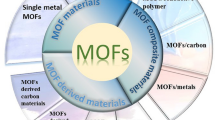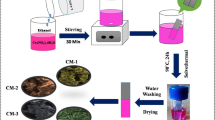Abstract
The double-activated porous carbons (DAPCs) with unique bimodal pore structure were prepared by activating commercial microporous carbon (CMCs) twice through KOH (double activation) at high temperature. The as-prepared DAPCs show larger surface area (833 m2·g−1), and the pores are composed of micropores (size of ~1.8 nm) and mesopores (size of ~4.5 nm). Such special hierarchical porous structures integrate the dual advantages of micropore and mesopore, having not only the high energy storage of the micropores but also the high-rate performance of the mesopores for supercapacitors (SCs). As a result, the optimized DAPCs-3-1 exhibits a high specific capacitance of 277 F·g−1 at 1 A·g−1, enhanced rate performance of 197 F·g−1 at a high current density of 10 A·g−1, and excellent cycling stability with 94.2% capacity retention after 10,000 cycles in the 1 mol·L−1 Na2SO4 electrolyte. The facile double activation could be a promising method to prepare suitable porous carbons with exceptional electrochemical properties for SCs.








Similar content being viewed by others
References
Kumar VB, Borenstein A, Markovsky B, Aurbach D, Gedanken A, Talianker M, Porat Z. Activated carbon modified with carbon nanodots as novel electrode material for supercapacitors. J Phys Chem C. 2016;120(25):13406.
Faraji S, Ani FN. The development supercapacitor from activated carbon by electroless plating—a review. Renew Sustain Energy Rev. 2015;42:823.
Chen Q, Hu Y, Hu CG, Cheng HH, Zhang ZP, Shao HB, Qu LT. Graphene quantum dots-three-dimensional graphene composites for high-performance supercapacitors. Phys Chem Chem Phys. 2014;16(36):19307.
Tian YH. The development of supercapacitor with porous carbon materials. J Power Sources. 2002;26(6):466.
Yoo EJ, Kim J, Hosono E. Large reversible Li storage of graphene nanosheet families for use in rechargeable lithium ion batteries. Nano Lett. 2008;8(8):2277.
Yuan B, Zhou L, Guan DA. The develpoment of supercapacitor with carbon-bassed electrode materials. Mar Electr Eng. 2016;36(1):33.
Kota M, Yu X, Yeon SH, Cheong HW, Park HS. Ice-templated three dimensional nitrogen doped graphene for enhanced supercapacitor performance. J Power Sources. 2016;303:372.
Zhang L, DeArmond D, Alvarez NT, Zhao D, Wang T, Hou G, Malik R, Heineman WR, Shanov V. Beyond graphene foam, a new form of three-dimensional graphene for supercapacitor electrodes. J Mater Chem A. 2016;4(9):1876.
Lamberti A, Clerici F, Fontana M, Scaltrito LA. Highly stretchable supercapacitor using laser-induced graphene electrodes onto elastomeric substrate. Adv Energy Mater. 2016;6(10):1600050.
Bose S, Kuila T, Mishra AK, Rajasekar R, Kim NH, Lee JH. Carbon-based nanostructured materials and their composites as supercapacitor electrodes. J Mater Chem. 2012;22(3):767.
Qiu YC, Li G, Hou Y, Pan Z, Li HF, Li WF, Liu MN, Ye FM, Yang XW, Zhang YG. Vertically aligned carbon nanotubes on carbon nanofibers: a hierarchical three-dimensional carbon nanostructure for high-energy flexible supercapacitors. Chem Mater. 2015;27(4):1194.
Park JW, Park SJ, Kwon OS, Lee C, Jang J, Jang J, Park JW, Park SJ, Lee C, Kwon OS. In situ synthesis of graphene/polyselenophene nanohybrid materials as highly flexible energy storage electrodes. Chem Mater. 2014;26(7):2354.
Pierre AC, Pajonk GM. Chemistry of aerogels and their applications. Chem Rev. 2002;102(11):4243.
Moreno-Castilla C, Maldonado-Hódar FJ. Carbon aerogels for catalysis applications: an overview. Carbon. 2005;43(3):455.
Nardecchia S, Carriazo D, Ferrer ML, Gutierrez MC, del Monte F. Three dimensional macroporous architectures and aerogels built of carbon nanotubes and/or graphene: synthesis and applications. Chem Soc Rev. 2013;42(2):794.
Chen Z, Wen J, Yan CZ, Rice L, Sohn H, Shen MQ, Cai M, Dunn B, Lu YF. High-performance supercapacitors based on hierarchically porous graphite particles. Adv Energy Mater. 2011;1(4):551.
Mun Y, Jo C, Hyeon T, Lee J, Ha KS, Jun KW, Lee SH, Hong SW, Lee HI, Yoon S, Lee J. Simple synthesis of hierarchically structured partially graphitized carbon by emulsion/block-copolymer co-template method for high power supercapacitors. Carbon. 2013;64:391.
Ma C, Song Y, Shi JL, Zhang DQ, Zhai XL, Zhong M, Guo QG, Liu L. Preparation and one-step activation of microporous carbon nanofibers for use as supercapacitor electrodes. Carbon. 2013;51:290.
Lei Z, Christov N, Zhang LL, Zhao XS. Mesoporous carbon nanospheres with an excellent electrocapacitive performance. J Mater Chem. 2011;21(7):2274.
Dai L. Functionalization of graphene for efficient energy conversion and storage. Acc Chem Res. 2013;46(1):12.
Hu CG, Zhang YY, Bao G, Zhang YL, Liu ML, Wang ZL. Diameter-dependent voltammetric properties of carbon nanotubes. Chem Phys Lett. 2006;418(4):524.
Kang DM, Liu QL, Gu JJ, Su YS, Zhang W, Zhang D. “Egg-Box”-assisted fabrication of porous carbon with small mesopores for high-rate electric double layer capacitors. ACS Nano. 2015;9(11):11225.
Wang DW, Li F, Liu M, Lu GQ, Cheng HM. 3D aperiodic hierarchical porous graphitic carbon material for high-rate electrochemical capacitive energy storage. Angew Chem. 2007;120(2):379.
Wu ZS, Sun Y, Tan YZ, Yang S, Feng X, Müllen K. Three-dimensional graphene-based macro- and mesoporous frameworks for high-performance electrochemical capacitive energy storage. J Am Chem Soc. 2012;134(48):19532.
Chmiola J, Yushin G, Gogotsi Y, Portet C, Simon P, Taberna PL. Anomalous increase in carbon capacitance at pore sizes less than 1 nanometer. Science. 2006;313(5794):1760.
Wei XJ, Jiang XQ, Wei JS, Gao SY. Functional groups and pore size distribution do matter to hierarchically porous carbons as high-rate-performance supercapacitors. Chem Mater. 2016;28(2):445.
Li MC, Wang WX, Yang MY, Lv FC, Cao LJ, Tang YG, Sun R, Lu ZG. Large-scale fabrication of porous carbon decorated iron oxide microcuboids from Fe–MOF as high-performance anode materials for lithium-ion batteries. RSC Adv. 2015;5(10):7356.
Tao PP, Hu J, Wang WX, Wang S, Li MC, Zhong H, Tang YG, Lu ZG. Porous graphitic carbon prepared from the catalytic carbonization of Mo-containing resin for supercapacitors. RSC Adv. 2014;4(26):13518.
Hu J, Tao PP, Wang S, Liu Y, Tang YG, Zhong H, Lu ZG. Preparation of highly graphitized porous carbon from resins after the treatment of Cr6+-containing wastewater for supercapacitors. J Mater Chem A. 2013;1(22):6558.
Lillo-Ródenas MA, Juan-Juan J, Cazorla-Amorós D, Linares-Solano A. About reactions occurring during chemical activation with hydroxides. Carbon. 2004;42(7):1371.
Lillo-Rodenas MA, Cazorla-Amoros D, Linares-Solano A. Understanding chemical reactions between carbons and NaOH. Carbon. 2003;41(2):267.
Mckee DW. Gasification of graphite in carbon dioxide and water vapour—the catalytic effects of alkali metal salts. Carbon. 1982;20(1):59.
Jain A, Aravindan V, Jayaraman S, Kumar PS, Balasubramanian R, Ramakrishna S, Madhavi S, Srinivasan MP. Activated carbons derived from coconut shells as high energy density cathode material for Li–ion capacitors. Sci Rep. 2013;3:3002.
Carrot PJM, Roberts RA, Sing KSW. Adsorption of nitrogen by porous and non-porous carbons. Carbon. 1987;25(1):59.
Sing KS, Everett DH, Haul AW, Moscou L, Pierotti RA, Rouquerol J, Siemieniewska T. Physical and biophysical chemistry division commission on colloid and surface chemistry including catalysis. Pure Appl Chem. 1985;57(4):17.
Sing KSW, Everett DH, Haul AW, Moscou L, Pierotti RA, Rouquerol J, Siemieniewska T. Reporting physisorption data for gas solid systems with special reference to the determination of surface area and porosity. Pure Appl Chem. 1985;57(4):603.
Simon P, Gogotsi Y. Materials for electrochemical capacitors. Nat Mater. 2008;7(11):845.
Wang Q, Wen ZH, Li JH. A hybrid supercapacitor fabricated with a carbon nanotube cathode and a TiO2–B nanowire anode. Adv Funct Mater. 2006;16(16):2141.
Qu GX, Cheng JL, Li XD, Yuan DM, Chen PN, Chen XL, Wang B, Peng HS. A fiber supercapacitor with high energy density based on hollow graphene/conducting polymer fiber electrode. Adv Mater. 2016;28(19):3646.
Choi BG, Hong J, Hong WH, Hammond PT, Park H. Facilitated ion transport in all-solid-state flexible supercapacitors. ACS Nano. 2011;5(9):7205.
Acknowledgments
This work was financially supported by the National Natural Science Foundation of China (No. 51472110), Shandong Provincial Natural Science Foundation (No. ZR2016EMB05), University of Jinan Science Foundation (No. XKY1630), and a Research Project from Ministry of Education, China (No. 213021A).
Author information
Authors and Affiliations
Corresponding author
Rights and permissions
About this article
Cite this article
Sun, J., Yang, SH., Li, SS. et al. Double-activated porous carbons for high-performance supercapacitor electrodes. Rare Met. 36, 449–456 (2017). https://doi.org/10.1007/s12598-017-0896-7
Received:
Revised:
Accepted:
Published:
Issue Date:
DOI: https://doi.org/10.1007/s12598-017-0896-7




